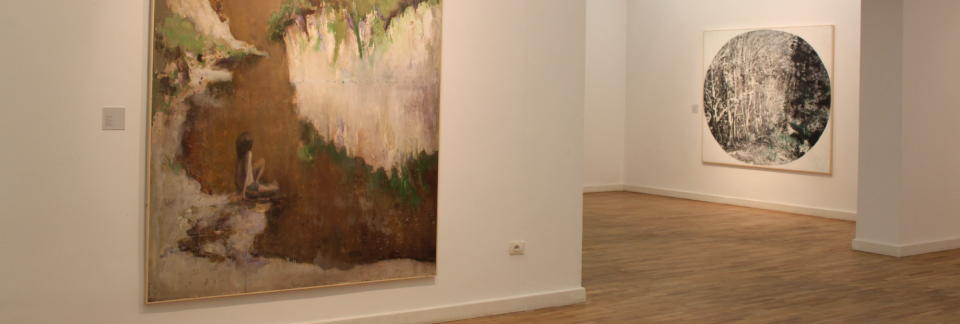The Scent of the Forest / Daniele Capra

The relationship between art and reality has always been one of the most complex issues for all those that use such expressive means. Gone is the old-fashioned idea of mimesis, according to which art, thus painting too, should serve to represent reality (es-pecially nature, regarded as the highest example of beauty), or to mediate between the sensible world and the divine aspect. From late Renaissance on, the artist understood how the work itself could claim an expressive, self-sustaining autonomy. In particular, painting’s strength and its ability to generate autonomous signs and symbols, freed the artist from being held accountable for his unnatural and bizarre creations, or, as Bonito Oliva argues in L’ideologia del traditore, “to deal with the generated catastrophe the mannerist artist dresses himself in the armour of style.” The painting of Orion Shima exemplifies this kind of approach — one of the prime artistic weapons used by all the avant-garde movements from the I 900’s on — that provides enough creative freedom to deal with any challenges or obstacles that come his way and search in every direction without constraints or restrictions. In fact, this Albanian artist adopts a polymorphous style characterized by nuanced, subtle changes in each piece of work. This allows him to mix, with an air of freshness, solutions of surface, purely of a technical nature, with thematic choices that are marked by an inti-mate closeness to nature. If, in fact, Shima’s work owes something to the impressionist technique of Degas and Renoir, it is in the subject matter, in that magical, glowing atmo-sphere of nature, where he exhibits his distinct style, displaying through each new work something entirely unique and varied in its representation of landscape. In Shima’s paintings, nature is characterized by an aura of fairies, reminiscent of bedtime stories. Every tree branch sways at the right place, every animal roams freely displaying its beauty, a magnetic vitality forcing the spectator to pause and stare. As in the Rime of the Ancient Mariner by Samuel Taylor Coleridge, when a wedding guest is captivated by an old sailor’s mesmerizing, incredibly detailed account of living at sea, Shima’s works compel even the casual observer to study carefully each brushstroke. Thanks to the eye — not the spellbound eye told in the tale of the old mariner, but that of the ob-server — the seduction happens almost miraculously. In fact, Shima shifts the pathos he creates on the beholder, through such a method which makes it impossible to avoid looking. On the other hand, it’s as Giovan Battista Marino argued during the baroque époque: “in the end the miracle is of the poet.” Literature, just like art, has among its aims the creation of images that attempt to surprise, to shake and move the reader. Marvel-ling, taking your breath away, simply doesn’t come from trying to create an effect, but from the need of taking the viewer by the hand to a strange, unimaginable place. As in traditional European tales, the forest symbolically represents an unknown place since topologically it is at once complex and elusive. Psychologically, it is a complex space that cannot be subjugated by humans, it is a place where wild animals live — creatures that posses a rich dowry of capabilities (that can be interpreted allegorically as well) where they manage to freely roam. In this magical universe, often distinguished by a colour scale that moves from murky gray to the white of the falling snow, there is plenty of space to marvel, to rediscover the tracks of a distant world which serves as an enclosure that nurtures the fantasy of the viewer. Between the trees, in a clearing full of mist, a powerful and antlered deer appears. It is a furtive and sudden appearance, a presence that seems to startle the animal and the viewer. In a heartbeat it raises its head: what scent does it detect? Or is it simply grazing, unperturbed? We will never find out, and maybe it doesn’t matter at all. The deer can be real or perhaps a projection of our unconsciousness — in effect Shima’s painting exists equally in real events and imagined facts. Like the fog in Federico Fellini’s Amarcord, the forest symbolizes the unconscious space of the imaginary: it is the enclosure that surrounds people and which constantly reveals and hides their characteristic elements. All these presences, all these figures, even the glances of whoever is trying to uncover something at any cost — but ends up with a handful of flies — seem furtive and escaping. The landscape, dried out and dreamlike, is the inner framework which holds true all those impressions that do not correspond to daily reality. There is a spring of life, of stimuli, of colours, of trees that intertwine without an afterthought of continuity, while a wolf howls in its cage and a bird flutters. Thus, the painting shows an autonomous discipline, with an elevated generative strength, where things untrue and untrammelled, visions and ghosts, can be told, rendering all this, true and alive. And, at the same time, to our satisfaction, terribly vital and necessary.
Daniele Capra
